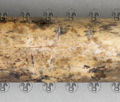VN-10
| Inscription | |
|---|---|
| Transliteration: | laθur / lumene χa / lu |
| Original script: | |
|
| |
| Object: | VN-10 bone (bone) |
| Position: | front, right area"right area" is not in the list (front, back, top, bottom, inside, outside, neck, shoulder, foot, handle, ...) of allowed values for the "position" property. |
| Script: | North Italic script (Sanzeno alphabet) |
| Direction of writing: | sinistroverse |
| Letter height: | 1.21.2 cm <br /> – 1.7 cm |
| Number of letters: | 11 – 15 |
| Number of characters: | 15 |
| Number of lines: | 3 |
| Craftsmanship: | engraved |
| Current condition: | complete |
| Date of inscription: | 3rd–1st centuries BC [from object] |
| Date derived from: | archaeological context [from object] |
|
| |
| Language: | Raetic |
| Meaning: | unknown |
|
| |
| Alternative sigla: | TM 653625 |
| Sources: | Schumacher 2004: 322 f. |
Images
|
Object VN-10 bone with inscription VN-10.
|
Object VN-10 bone with inscription VN-10.
|
Inscription VN-10 - line 2 / left part.
|
Inscription VN-10 - line 1.
|
Inscription VN-10 - line 2 / right part.
|
|
Inscription VN-10 - line 3.
|
Commentary
First published in Schumacher 2004: 322 ff.
Images in Steiner & Gamper 1999: Abb. 24,7 and Schumacher 2004: Taf. 13,1 (drawing).
Length 3.2 cm (line 1); 7.3 cm (line 2). The letters are not particularly tidy, the lines being made up of numerous small scratches, and rather slightly scratched, but nevertheless well legible. The greater part of the text is inscribed on the smooth rounded surface as is usual on this type of bone, but at some points the lines cross the edges between "front" and "back" of the bone for no apparent reason. ![]() in line 1 is written right across the edge;
in line 1 is written right across the edge; ![]() is put lower with only its tip curving around the edge; the rest of the line follows the edge neatly. Line 2 is fitted tightly between line 1 and the other edge, some of its letters reaching up among the letters of line 1. There is a distinct gap between
is put lower with only its tip curving around the edge; the rest of the line follows the edge neatly. Line 2 is fitted tightly between line 1 and the other edge, some of its letters reaching up among the letters of line 1. There is a distinct gap between ![]()
![]()
![]()
![]()
![]()
![]() and
and ![]()
![]() . The hasta of
. The hasta of ![]() is only slightly prolonged in the bottom;
is only slightly prolonged in the bottom; ![]() in line 2 features a doubled bar, cp. BZ-3. Line 3 contains two doubtful letters inscribed on the "back" of the bone. This part is not usually used for inscriptions, probably because is was softer and/or more poriferous than the rounded "front". Accordingly, the inscribed lines are more eroded, while the lower tips of the two characters, which curve around one of the edges, are clearly visible. It is unclear whether these characters belong with the others, or what purpose they fulfil.
in line 2 features a doubled bar, cp. BZ-3. Line 3 contains two doubtful letters inscribed on the "back" of the bone. This part is not usually used for inscriptions, probably because is was softer and/or more poriferous than the rounded "front". Accordingly, the inscribed lines are more eroded, while the lower tips of the two characters, which curve around one of the edges, are clearly visible. It is unclear whether these characters belong with the others, or what purpose they fulfil.
laθur appears to be an individual name despite its unusual consonantal auslaut. The sequence lumene χa is found on a bone point from the Ganglegg, separated by a punctuation mark. Cp. also VN-15. It is questionable whether ![]()
![]() should be read χa at all, or whether it ought to be regarded as a non-script element, possibly a number. Cp. VN-17 and possibly VN-8 with a group
should be read χa at all, or whether it ought to be regarded as a non-script element, possibly a number. Cp. VN-17 and possibly VN-8 with a group ![]()
![]() following the inscription. See here for a discussion of possible numerical notation. Even if Schumacher 1998: 101 is right in interpreting lumene as another individual name, χa can hardly be the enclitic conjunction, though it appears as -ka in ancient Etruscan, since on VN-11, lumene·χa is not accompanied by a(nother) name.
following the inscription. See here for a discussion of possible numerical notation. Even if Schumacher 1998: 101 is right in interpreting lumene as another individual name, χa can hardly be the enclitic conjunction, though it appears as -ka in ancient Etruscan, since on VN-11, lumene·χa is not accompanied by a(nother) name.


